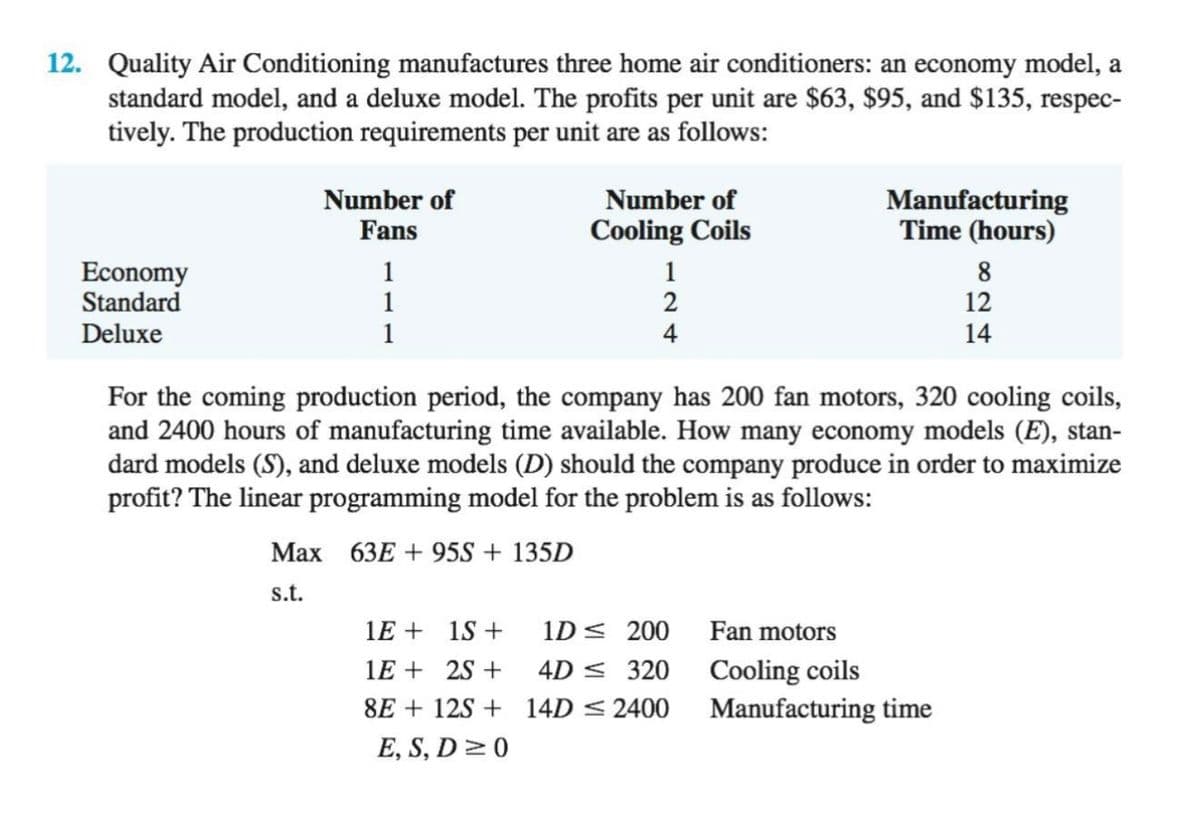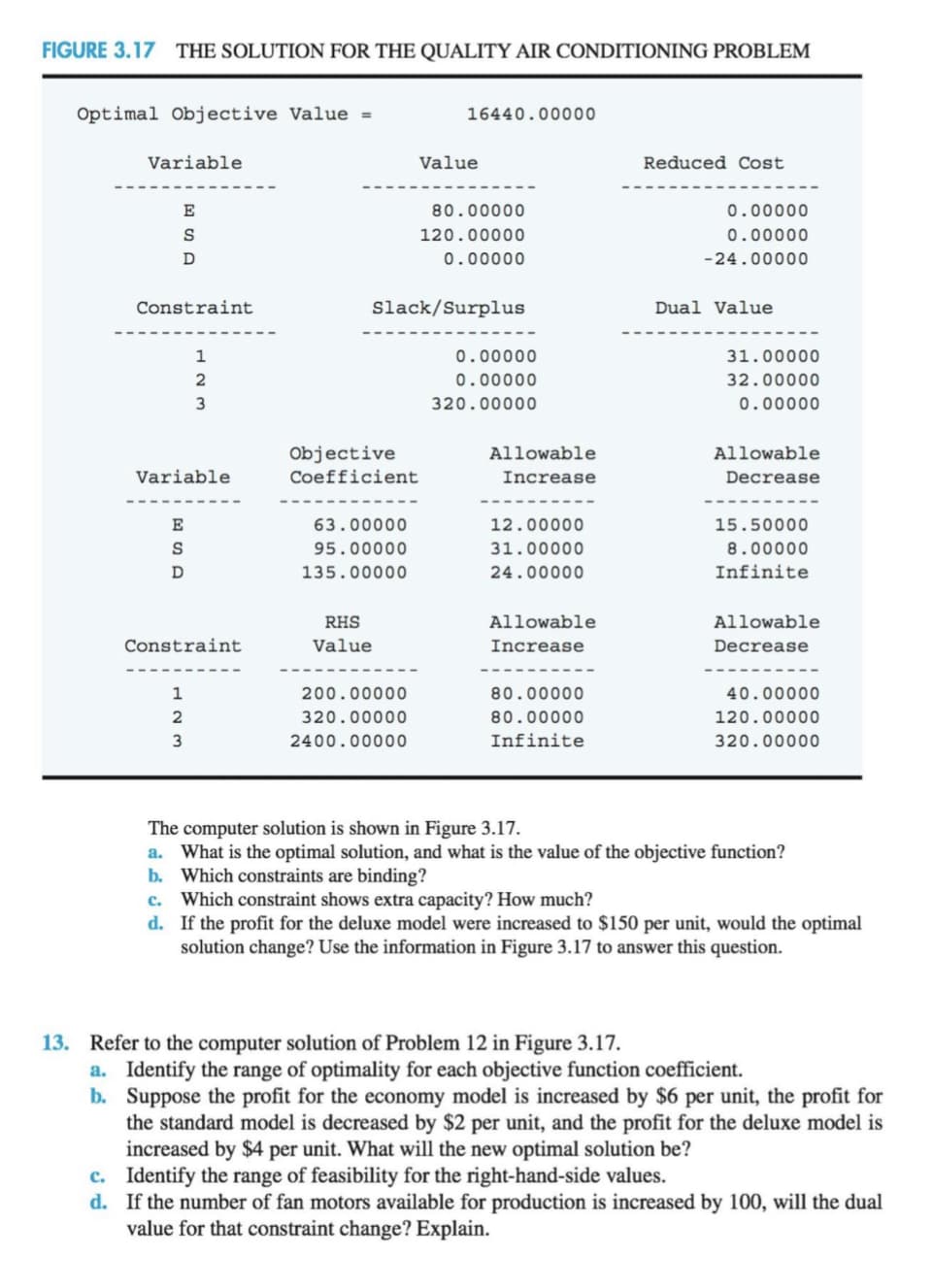13. Refer to the computer solution of Problem 12 in Figure 3.17. a. Identify the range of optimality for each objective function coefficient. b. Suppose the profit for the economy model is increased by $6 per unit, the profit for the standard model is decreased by $2 per unit, and the profit for the deluxe model is increased by $4 per unit. What will the new optimal solution be? c. Identify the range of feasibility for the right-hand-side values. d. If the number of fan motors available for production is increased by 100, will the dual value for that constraint change? Explain.
13. Refer to the computer solution of Problem 12 in Figure 3.17. a. Identify the range of optimality for each objective function coefficient. b. Suppose the profit for the economy model is increased by $6 per unit, the profit for the standard model is decreased by $2 per unit, and the profit for the deluxe model is increased by $4 per unit. What will the new optimal solution be? c. Identify the range of feasibility for the right-hand-side values. d. If the number of fan motors available for production is increased by 100, will the dual value for that constraint change? Explain.
Advanced Engineering Mathematics
10th Edition
ISBN:9780470458365
Author:Erwin Kreyszig
Publisher:Erwin Kreyszig
Chapter2: Second-order Linear Odes
Section: Chapter Questions
Problem 1RQ
Related questions
Question
100%
I need question 13, question 12 is for background information

Transcribed Image Text:12. Quality Air Conditioning manufactures three home air conditioners: an economy model, a
standard model, and a deluxe model. The profits per unit are $63, $95, and $135, respec-
tively. The production requirements per unit are as follows:
Number of
Fans
Manufacturing
Time (hours)
Number of
Cooling Coils
Economy
Standard
Deluxe
1
8
1
2
1
12
1
4
14
For the coming production period, the company has 200 fan motors, 320 cooling coils,
and 2400 hours of manufacturing time available. How many economy models (E), stan-
dard models (S), and deluxe models (D) should the company produce in order to maximize
profit? The linear programming model for the problem is as follows:
Max 63E + 95S + 135D
s.t.
1E + 1S +
1D< 200
Fan motors
1E + 2S +
Cooling coils
Manufacturing time
4D < 320
8E + 12S + 14D < 2400
E, S, D 0

Transcribed Image Text:FIGURE 3.17 THE SOLUTION FOR THE QUALITY AIR CONDITIONING PROBLEM
Optimal Objective Value =
16440.00000
Variable
Value
Reduced Cost
E
80.00000
0.00000
S
120.00000
0.00000
D
0.00000
-24.00000
Constraint
Slack/Surplus
Dual Value
1
0.00000
31.00000
2
0.00000
32.00000
3
320.00000
0.00000
Objective
Coefficient
Allowable
Allowable
Variable
Increase
Decrease
E
63.00000
12.00000
15.50000
95.00000
31.00000
8.00000
D
135.00000
24.00000
Infinite
RHS
Allowable
Allowable
Constraint
Value
Increase
Decrease
1
200.00000
80.00000
40.00000
2
320.00000
80.00000
120.00000
3
2400.00000
Infinite
320.00000
The computer solution is shown in Figure 3.17.
a. What is the optimal solution, and what is the value of the objective function?
b. Which constraints are binding?
c. Which constraint shows extra capacity? How much?
d. If the profit for the deluxe model were increased to $150 per unit, would the optimal
solution change? Use the information in Figure 3.17 to answer this question.
13. Refer to the computer solution of Problem 12 in Figure 3.17.
a. Identify the range of optimality for each objective function coefficient.
b. Suppose the profit for the economy model is increased by $6 per unit, the profit for
the standard model is decreased by $2 per unit, and the profit for the deluxe model is
increased by $4 per unit. What will the new optimal solution be?
c. Identify the range of feasibility for the right-hand-side values.
d. If the number of fan motors available for production is increased by 100, will the dual
value for that constraint change? Explain.
Expert Solution
This question has been solved!
Explore an expertly crafted, step-by-step solution for a thorough understanding of key concepts.
This is a popular solution!
Trending now
This is a popular solution!
Step by step
Solved in 2 steps with 2 images

Recommended textbooks for you

Advanced Engineering Mathematics
Advanced Math
ISBN:
9780470458365
Author:
Erwin Kreyszig
Publisher:
Wiley, John & Sons, Incorporated

Numerical Methods for Engineers
Advanced Math
ISBN:
9780073397924
Author:
Steven C. Chapra Dr., Raymond P. Canale
Publisher:
McGraw-Hill Education

Introductory Mathematics for Engineering Applicat…
Advanced Math
ISBN:
9781118141809
Author:
Nathan Klingbeil
Publisher:
WILEY

Advanced Engineering Mathematics
Advanced Math
ISBN:
9780470458365
Author:
Erwin Kreyszig
Publisher:
Wiley, John & Sons, Incorporated

Numerical Methods for Engineers
Advanced Math
ISBN:
9780073397924
Author:
Steven C. Chapra Dr., Raymond P. Canale
Publisher:
McGraw-Hill Education

Introductory Mathematics for Engineering Applicat…
Advanced Math
ISBN:
9781118141809
Author:
Nathan Klingbeil
Publisher:
WILEY

Mathematics For Machine Technology
Advanced Math
ISBN:
9781337798310
Author:
Peterson, John.
Publisher:
Cengage Learning,

